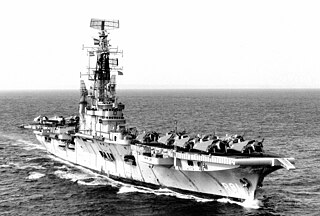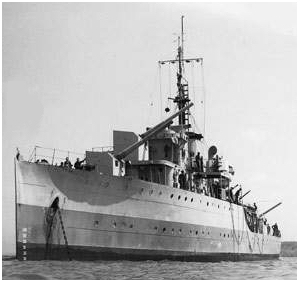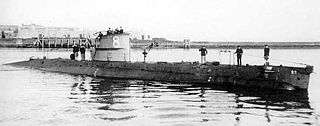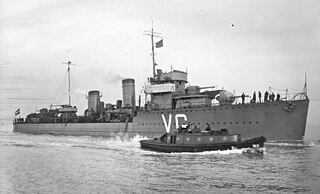Service history
When the war broke out, Johan Maurits van Nassau was in the West Indies due to be relieved by the new gunnery training ship Van Kinsbergen, allowing Johan Maurits van Nassau to return to the Netherlands. On 10 May 1940, the day the Germans launched their invasion, she was stationed as a search and guard vessel at Vlissingen, where she immediately was targeted by German aircraft, of which she shot down one. She remained in the area for a couple of days and was then ordered to bombard the Dutch aerodrome at Waalhaven in Rotterdam, which had been occupied by German paratroopers. She arrived in Hook of Holland, but after the loss of the destroyer Van Galen during her attempt to do the same, the operation—of which Flores was also part—was cancelled.
As part of the Battle of the Afsluitdijk, Johan Maurits van Nassau was ordered by Den Helder on 12 May 1940 to silence a German battery near the Afsluitdijk, and on 14 May, she bombarded the German battery (consisting of 88 mm (3.46 in) guns of the 1. Kavalleriedivision) at a range of about 18 km (11 mi) and silenced them. Her advanced fire control system enabled great accuracy. Despite fierce retaliation by German aircraft, she remained undamaged, to the great surprise of all.
The war in the Netherlands was, however, coming to an end, and the independent role of the Dutch Navy was over. There was a general evacuation of personnel and ships, and Johan Maurits van Nassau left Den Helder on 14 May with the minelayers HNLMS Jan van Brakel, Douwe Aukes and Nautilus, and the torpedo boats G 13 and G 15. In the afternoon, about 16 km (10 mi) west of Callantsoog, they were attacked by German aircraft. Johan Maurits van Nassau—the largest vessel in the convoy—was the main target. Johan Maurits van Nassau received two or three hits, one of which caused a fire near an ammunition stack. The crew were ordered to abandon ship: 17 crewmen were killed. Later, most surviving crewmembers were transported back to Den Helder by the rescue ship Dorus Rijkers, but some continued to England aboard the remaining ships.
The wreck lies in 20 m (66 ft) of water in position 52°50′13″N4°33′56″E / 52.83694°N 4.56556°E / 52.83694; 4.56556 .
The Royal Netherlands Navy is the naval force of the Kingdom of the Netherlands. It is one of the four Netherlands Armed Forces. It was founded on 8 January 1488, making it the third-oldest naval force in the world.

Karel Willem Frederik Marie Doorman was a Dutch naval officer who during World War II commanded remnants of the short-lived American-British-Dutch-Australian Command naval strike forces in the Battle of the Java Sea. He was killed in action when his flagship HNLMS De Ruyter was torpedoed during the battle, having chosen to go down with the ship.

John Maurice of Nassau, called "the Brazilian" for his fruitful period as governor of Dutch Brazil, was Count and Prince of Nassau-Siegen. He served as Herrenmeister of the Order of Saint John from 1652 until his death in 1679.

HNLMS Karel Doorman (R81) was a Colossus-class aircraft carrier of the Royal Netherlands Navy. Formerly the British ship HMS Venerable, she was sold to the Netherlands in 1948 as a light attack carrier. In 1960, she was involved in the decolonization conflict in Western New Guinea with Indonesia. In the mid 1960s, her role was changed to anti-submarine warfare carrier and only ASW aircraft and helicopters were carried. An engine room fire took her out of service in 1968. She was sold to Argentina in 1969 and renamed ARA Veinticinco de Mayo.

An aviso was originally a kind of dispatch boat or "advice boat", carrying orders before the development of effective remote communication.

The Flores-class gunboats were a class of two gunboats built in the mid-1920s for the Royal Netherlands Navy. Flores and Soemba were intended to patrol the Dutch East Indies. During World War II, they served in the Royal Netherlands Navy. They were in several ways the most successful surface ships of the Dutch navy during the war.

HNLMS Flores was a Flores-class gunboat built in the mid-1920s for the Royal Netherlands Navy to patrol the Dutch East Indies.

The Holland-class destroyers were built for the Royal Netherlands Navy in the 1950s. They were the first major warships designed and built by the Dutch after World War II. In contrast to previous Dutch Navy practice the ships were named after provinces rather than admirals.

HMS H6 was a British H-class submarine of the Royal Navy built by Canadian Vickers & Co. during World War I.

HNLMS Karel Doorman is a multi-function support ship for amphibious operations of the Royal Netherlands Navy, which is also used by the German Navy. The ship replaced both of the navy's replenishment oilers: HNLMS Zuiderkruis and HNLMS Amsterdam. At 204.7 m she is the largest ship in service with the Royal Netherlands Navy.

The Battle of the Afsluitdijk of 12–14 May 1940 was an unsuccessful attempt by German Wehrmacht forces to seize the Afsluitdijk during the invasion of the Netherlands. German invasion plans called for a simultaneous attack on Vesting Holland from multiple directions, expecting to capture the country's capital and most important region in a day's time.

HNLMS Pieter Florisz was a Jan van Amstel-class minesweeper of the Royal Netherlands Navy and Nazi Germany's Kriegsmarine during World War II.

HNLMS Douwe Aukes was a minelayer of the Royal Netherlands Navy. She was built in the Gusto shipyard at Schiedam as the lead ship of the Douwe Aukes class, and one of her early commanders was Eugène Lacomblé.

HNLMS Van Kinsbergen was a unique sloop of the Royal Netherlands Navy build by Rotterdamsche Droogdok Maatschappij. She served in the Dutch West Indies in 1940. Later, she served as escort vessel and survived World War II. She was decommissioned on 29 May 1959 and was sold for scrap on 19 May 1974.

O 13 was an O 12-class submarine of the Royal Netherlands Navy that saw service during World War II. She was built by the Koninklijke Maatschappij De Schelde of Vlissingen. She was one of many Dutch ships doing convoy duty during the Spanish Civil War. At the time of the German invasion of the Netherlands, O 13 was on patrol off the Dutch coast and was attacked by German planes on multiple occasions. After fleeing to England, the submarine was lost during a patrol on the North Sea.

HNLMS Van Galen was a Admiralen-class destroyer of the Royal Netherlands Navy, named after the 17th century Dutch Commodore Johan van Galen. She served during World War II. The opening chapter of E.H.Larive's autobiography 'The Man Who Came In From Colditz' describes in detail the craft's demise.

The Roofdier class was a class of six frigates that were built in the United States as Patrol Craft Escorts (PCE) for the Netherlands. The frigates were loaned to the Royal Netherlands Navy as part of the Mutual Defense Assistance Act (MDAP) and from 1954 to 1984 served as the Roofdier-class frigates.
At least two ships of the Royal Netherlands Navy have been named HNLMS Johan Maurits van Nassau after John Maurice of Nassau:

HNLMS Johan Maurits van Nassau (F802) was a River-class frigate of the Royal Netherlands Navy (RNN). She was built in the United Kingdom originally for the Royal Navy as HMS Ribble, however, during the construction the frigate was acquired by the RNN. She served in the RNN between 1943 and 1958.
This page is based on this
Wikipedia article Text is available under the
CC BY-SA 4.0 license; additional terms may apply.
Images, videos and audio are available under their respective licenses.

















